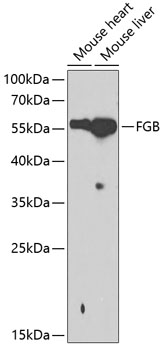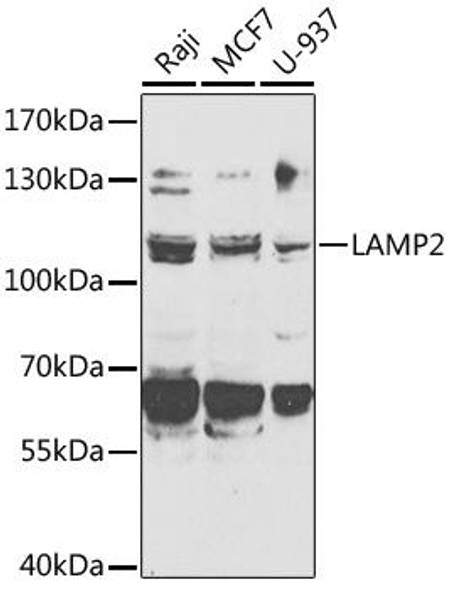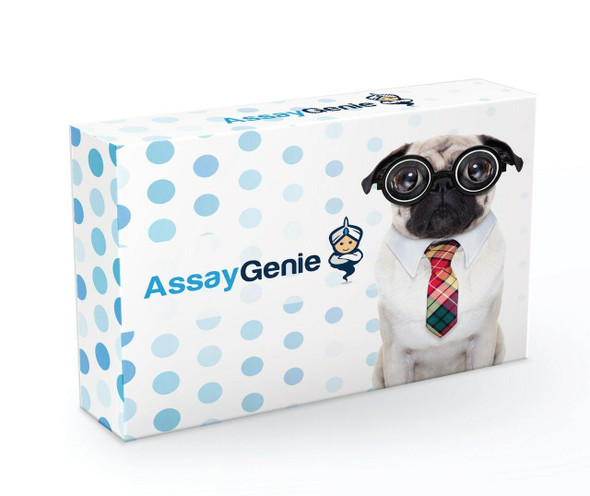Immunology Antibodies 1
Anti-FGB Antibody (CAB1401)
- SKU:
- CAB1401
- Product Type:
- Antibody
- Reactivity:
- Human
- Reactivity:
- Mouse
- Reactivity:
- Rat
- Host Species:
- Rabbit
- Isotype:
- IgG
- Antibody Type:
- Polyclonal Antibody
- Research Area:
- Immunology
Description
| Antibody Name: | Anti-FGB Antibody |
| Antibody SKU: | CAB1401 |
| Antibody Size: | 20uL, 50uL, 100uL |
| Application: | WB |
| Reactivity: | Human, Mouse, Rat |
| Host Species: | Rabbit |
| Immunogen: | Recombinant fusion protein containing a sequence corresponding to amino acids 202-491 of human FGB (NP_005132.2). |
| Application: | WB |
| Recommended Dilution: | WB 1:500 - 1:2000 |
| Reactivity: | Human, Mouse, Rat |
| Positive Samples: | Mouse heart, Mouse liver |
| Immunogen: | Recombinant fusion protein containing a sequence corresponding to amino acids 202-491 of human FGB (NP_005132.2). |
| Purification Method: | Affinity purification |
| Storage Buffer: | Store at -20'C. Avoid freeze / thaw cycles. Buffer: PBS with 0.02% sodium azide, 50% glycerol, pH7.3. |
| Isotype: | IgG |
| Sequence: | LENL RSKI QKLE SDVS AQME YCRT PCTV SCNI PVVS GKEC EEII RKGG ETSE MYLI QPDS SVKP YRVY CDMN TENG GWTV IQNR QDGS VDFG RKWD PYKQ GFGN VATN TDGK NYCG LPGE YWLG NDKI SQLT RMGP TELL IEME DWKG DKVK AHYG GFTV QNEA NKYQ ISVN KYRG TAGN ALMD GASQ LMGE NRTM TIHN GMFF STYD RDND GWLT SDPR KQCS KEDG GGWW YNRC HAAN PNGR YYWG GQYT WDMA KHGT DDGV VWMN WKGS WYSM RKMS MKIR PFFP QQ |
| Gene ID: | 2244 |
| Uniprot: | P02675 |
| Cellular Location: | Secreted |
| Calculated MW: | 55kDa |
| Observed MW: | 56kDa |
| Synonyms: | FGB, HEL-S-78p |
| Background: | The protein encoded by this gene is the beta component of fibrinogen, a blood-borne glycoprotein comprised of three pairs of nonidentical polypeptide chains. Following vascular injury, fibrinogen is cleaved by thrombin to form fibrin which is the most abundant component of blood clots. In addition, various cleavage products of fibrinogen and fibrin regulate cell adhesion and spreading, display vasoconstrictor and chemotactic activities, and are mitogens for several cell types. Mutations in this gene lead to several disorders, including afibrinogenemia, dysfibrinogenemia, hypodysfibrinogenemia and thrombotic tendency. Alternatively spliced transcript variants encoding different isoforms have been found for this gene. |
| UniProt Protein Function: | FGB: Fibrinogen has a double Function: yielding monomers that polymerize into fibrin and acting as a cofactor in platelet aggregation. Defects in FGB are a cause of congenital afibrinogenemia (CAFBN). This rare autosomal recessive disorder is characterized by bleeding that varies from mild to severe and by complete absence or extremely low levels of plasma and platelet fibrinogen. Patients with congenital fibrinogen abnormalities can manifest different clinical pictures. Some cases are clinically silent, some show a tendency toward bleeding and some show a predisposition for thrombosis with or without bleeding. |
| UniProt Protein Details: | Protein type:Cell surface; Secreted; Secreted, signal peptide; Adaptor/scaffold Chromosomal Location of Human Ortholog: 4q28 Cellular Component: extracellular space; cell surface; fibrinogen complex; extracellular region; plasma membrane; cell cortex; vesicle; external side of plasma membrane Molecular Function:protein binding, bridging; protein binding; chaperone binding; cell adhesion molecule binding; structural molecule activity; receptor binding Biological Process: protein polymerization; platelet activation; extracellular matrix organization and biogenesis; positive regulation of heterotypic cell-cell adhesion; cell-matrix adhesion; signal transduction; platelet degranulation; cellular protein complex assembly; positive regulation of protein secretion; positive regulation of vasoconstriction; innate immune response; response to calcium ion; blood coagulation; positive regulation of exocytosis Disease: Afibrinogenemia, Congenital; Dysfibrinogenemia, Congenital |
| NCBI Summary: | The protein encoded by this gene is the beta component of fibrinogen, a blood-borne glycoprotein comprised of three pairs of nonidentical polypeptide chains. Following vascular injury, fibrinogen is cleaved by thrombin to form fibrin which is the most abundant component of blood clots. In addition, various cleavage products of fibrinogen and fibrin regulate cell adhesion and spreading, display vasoconstrictor and chemotactic activities, and are mitogens for several cell types. Mutations in this gene lead to several disorders, including afibrinogenemia, dysfibrinogenemia, hypodysfibrinogenemia and thrombotic tendency. Alternatively spliced transcript variants encoding different isoforms have been found for this gene. [provided by RefSeq, Jun 2014] |
| UniProt Code: | P02675 |
| NCBI GenInfo Identifier: | 399492 |
| NCBI Gene ID: | 2244 |
| NCBI Accession: | P02675.2 |
| UniProt Secondary Accession: | P02675,Q32Q65, Q3KPF2, A0JLR9, B2R7G3, |
| UniProt Related Accession: | P02675 |
| Molecular Weight: | 55,928 Da |
| NCBI Full Name: | Fibrinogen beta chain |
| NCBI Synonym Full Names: | fibrinogen beta chain |
| NCBI Official Symbol: | FGB |
| NCBI Official Synonym Symbols: | HEL-S-78p |
| NCBI Protein Information: | fibrinogen beta chain; fibrinogen, B beta polypeptide; epididymis secretory sperm binding protein Li 78p |
| UniProt Protein Name: | Fibrinogen beta chain |
| Protein Family: | Fibrinogen |
| UniProt Gene Name: | FGB |
| UniProt Entry Name: | FIBB_HUMAN |







